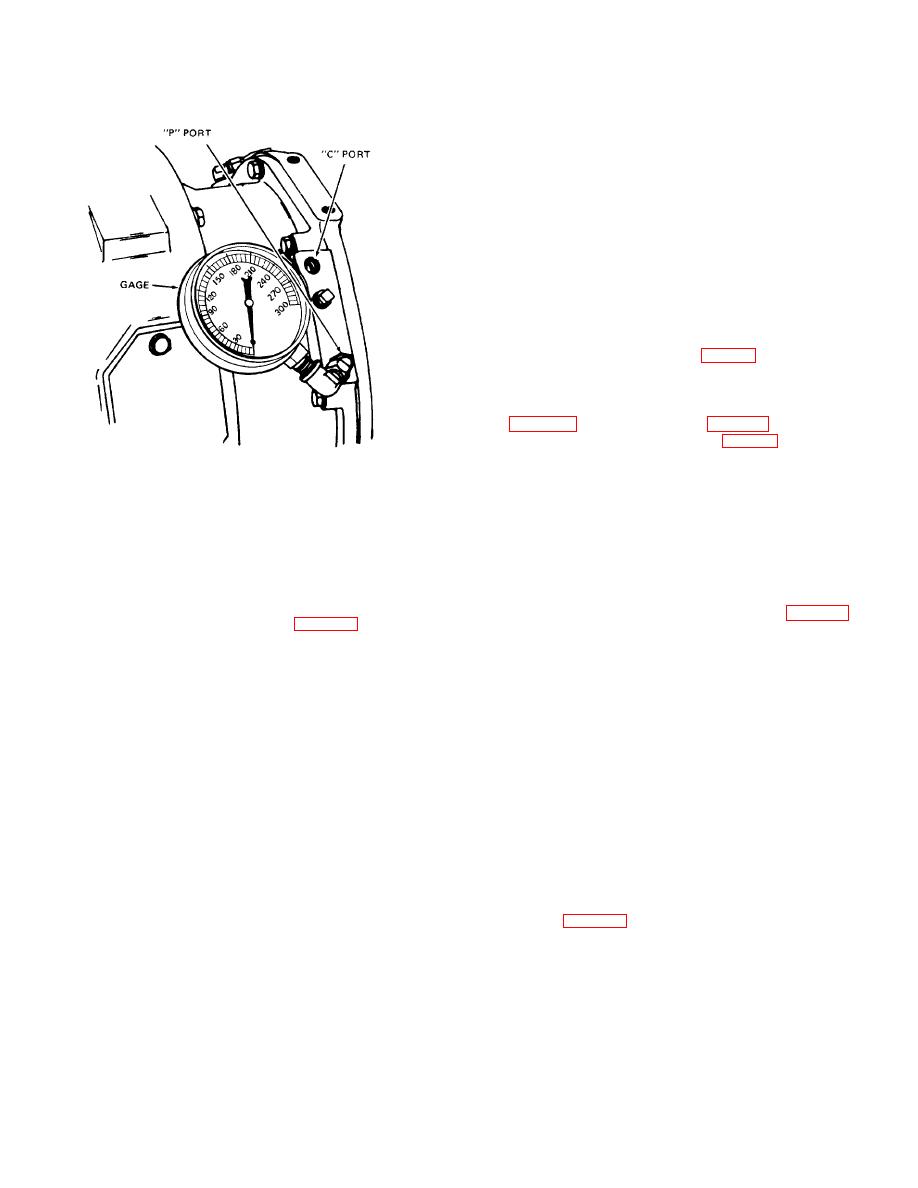 |
|||
|
|
|||
|
Page Title:
Figure 6-8. Checking pump and converter pressure. |
|
||
| ||||||||||
|
|
 TM 10-3930-621-34
(1) Install a pressure gage in front on top of control
salve.
(2) Check clutch pressure in forward direction as
follows:
(a) Position truck against wall and apply parking
and foot brake. Drive wheels must be locked.
(b) Accelerate engine momentarily to wide open
throttle and note pressure indication on gage.
(c) If gage reading is not below 65 psi. or does
not go above normal pump pressure, the pressure in the
forward circuit is normal. Pressure should never be
below 65 psi.
(d) If pressure is above normal pump pressure,
check for incorrect or faulty regulator spring (20, fig. 6-
11) tension, inoperative inching valve, or a restricted
orifice in the forward cylinder (3, fig. 6-7 ).
(e)If pressure is below 65 psi, check for low oil
level, restricted lines or passages, damaged collector
rings, faulty or incorrectly adjusted selector valve spool
(9, fig. 6-11), faulty pump 16, fig. 6-3), or excessive
leaks in the transmission drum (22, fig. 6-7).
(3) Check clutch pressure in reverse direction as
follows:
Figure 6-8. Checking pump and converter pressure.
(a) Install pressure gage in rear port on top of
control valve.
(3) Accelerate to full governed speed and note
(b) Idle engine and engage clutch in reverse
gage pressure.
direction.
(4) If pressure is 65 to 80 psi, converter is in
(c) If gage reading is 25+21/2 psi, the pressure in
normal operating condition.
the reverse circuit is normal.
(5) If pressure is above 80 psi, when engine is
(d) If pressure reading is not within tolerance,
accelerated, check the following:
adjust regulator valve and replace spring (20, fig. 6-11) if
(a) Exessive pump pressure (para 6-2 b (5).
necessary.
(b) Enlarged metering orifices.
e. Clutch-Pressure at Free Running.
(c) Restricted converter return passages.
(1) Raise both drive wheels off floor and block
(6) If pressure is below 65 psi, when engine is
securely. Both wheels must be free to rotate.
accelerated, check the following:
(2) Install pressure gage in front port on top of
(a) Low oil level
control valve.
(b) Restricted oil strainer
(3) Hold inching pedal up so inching valve plunger
(c) Faulty pump
cannot move.
(d) Clogged converter orifice in pump collector
(4) Run engine at full governed speed forward and
ring
check pressures. If pressure is below 65 psi or above
(e) Faulty cooler by-pass valve.
normal pump pressure, inspect in accordance with d
(7) Bring engine to idling speed.
above.
(8) If pressure is 40 to 60 psi, converter is in
(5) Install pressure gage in rear port on top of
normal operating condition.
control valve.
d.
Clutch
Pressure
at
Stall.
(6) With transmission in reverse, idle engine and
check pressure. If reading is not within 25t21/2 psi,
adjust oil cooler pressure regulator valve and replace
spring (20, fig. 6-11), if necessary.
6-11
|
|
Privacy Statement - Press Release - Copyright Information. - Contact Us |